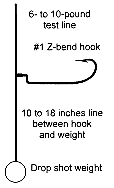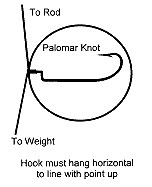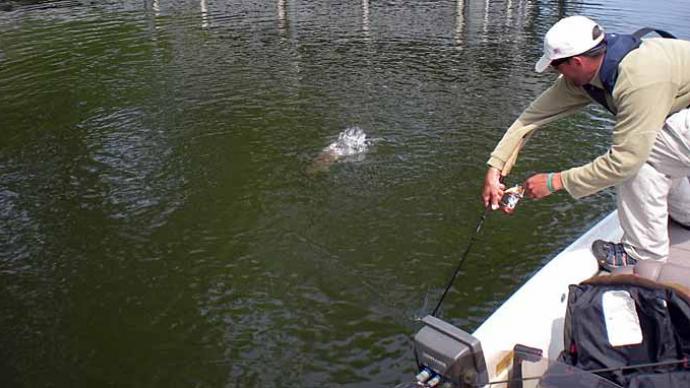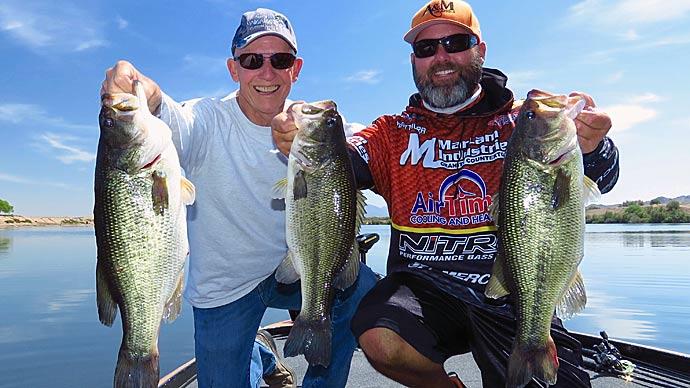
At a boat show in February this year, I helped in my sponsor's booth. In our conversations during the three days, I kept hearing about drop-shot rods. I didn't want to appear stupid, so the first time or two I heard it, I just played it safe and kept quiet. After the second day, dropshot fishing came up again, so I asked him to tell me about it. He said, "I'll tell you what, I've got a pro that lives in Phoenix. He's won over $45,000.00 using it. I'll have him call you."
So with the much-appreciated help of Brett Hite, we want to educate you on the use of the newest rigging technique for catching big bass after the spawn, during the hot summer, and even in the dead of winter.
Before we start on the rig, you've got to understand that after the spawn and in high-pressure situations, the home of the big bass is in deep water. By deep water, I mean anything deeper than eight to 12 feet. Notice I say big bass. Some fish are always shallow, and if there is a lot of structure or hiding places available, some big bass may be shallow. But every fisheries biologist you talk to will tell you that after the spawn, a big bass will not move one foot more than she has to eat. So after the two or three months of the year, when she moves shallow to spawn, her home is in deep water.
Deep water means different things in different places. For example, in Florida, where the deepest water in the lake is 10 to 20 feet, this is where she will be. But in California, Arizona, New Mexico, and some parts of Texas, deep water could be 60 or 70 feet, or even 90 feet deep or more.
If all this makes sense to you now, you say, "Okay, how do I find her?" Next, you must realize that fish move around and through a body of water using the same set of highways every day. That may be a creek channel, break line, or weed line extending into deep water. The crucial part of all this thinking is where the fish move toward the depth where they feed. The answer to this is found on the points, or bars if you want to call them that, which extend farthest out into the deepest water in the area.
Okay, we have established where the fish live and how they travel to the grocery store. Now we've got to put you at the spot where you can point your finger in the water and say, "I'm going to catch fish right here." This is done with your electronics and a set of marker buoys. You are hunting the longest, deepest, narrowest point that extends the farthest into the deepest water in the area. Let me say that again, longest, deepest, narrowest into the deepest water in the area. Got it?
At the mouth of a creek or even on an old do-nothing bank, points extend out into deep water. Using your big motor, idle across the point and mark the shallow top of the point. Next, move to eight to 10 feet and do the same thing. Keep moving deeper until you have a row of markers on this point and a sense of which way it heads. Keep doing this until your last buoy is on the spot, where it drops off into the deepest water in the area. This may be 25 or 30 feet in depth. Hite says most of his best fish on this rig are caught from 25 to as deep as 75 feet.
Now from the bank, idle straight out your buoy line and look for the heaviest concentration of fish or baitfish on the structure. Note the depth where they are at their shallowest point on the structure. If there are no fish on the structure, gather your markers and leave. Find another spot until you find one that does. If you practice this a few times, it only takes about 10 minutes to do, and even if you have to do it three times, I'll trade 30 minutes and an hour of big fish for six hours and small fish any day.
This process is easy if you use a Pinpoint positioning motor. Just head off the points until you find fish in 17 feet of water. Set the depth track at 17 feet and let it track until you find the longest point extending out into the deepest water. Now if you've done it right, you've got a marker on top of the point where the fish are holding. Pull up all the rest of the markers except this one because the one left is where you'll catch fish.

|
Image

Image

|
In cold-water months the fish may be holding in the deep creek channels or on the edges of the creek channels.
Hite says he prefers a spinning rig for dropshot fishing, but I used a Shimano Cronarch and found it to work well. I use a 6-foot 6-inch, medium-light power, and fast-tip action. Hite recommends an 8- or 10-pound fluorocarbon line. The hook of choice is the #1 EWG by Gamakatsu, but any super sharp wire hooks with a Z-bend to keep the bait in place will work. Last is the weight. A special drop-shot weight is in order because it's less prone to snagging. 1/4- or 3/8-ounce sizes are the most common.
The rig may sound like the simplest part of the system because it's a hook tied directly to the line from four inches to four-foot above the sinker. But how the hook rides the line is critical in getting this little hook in the fish on the hook set. Hite recommends you move up the line about four or five feet and double the line, go into the hook from the back side or opposite the point, tie a simple Palomar knot, and leave the tag end about four or five feet long. Then, take the tag end and go back through the hook eye from the point side toward the back. When you hang the weight, the hook will be at a 90-degree angle to the line with the hook point up.
Last is the weight and how far up the line the hook should be. Here's where you'll have to decide based on how high the fish are holding above the structure. If they're five feet above the structure, you may want the hook four feet above the weight, or in some instances, five or six inches may be enough. You'll just have to experiment to see what the fish want. Eighteen to 24 inches is an excellent place to start. I tie the bell sinker on with a slip-knot so I don't lose everything if it hangs up. Hang-ups will happen. See how to rig it.
If you haven't figured it out yet, the #1 size hook isn't going to work too well with a 10-inch worm or an 11-inch lizard. This is finesse-style fishing using small baits. There are a large number of manufacturers making baits for dropshot fishing. Many are hand-poured and come from the West Coast. This fishing style was invented and refined in the deep, clear-water lakes in Japan, California, and Arizona. It works best using a hand-poured super-soft bait with a lot of action when you shake it.
Ok, we've got the "where" this system works and the "what" in how you rig it. Now let's talk about the "how" you fish it to be most productive.
We've got our buoy out on the structure we intend to fish. We've got our rig built with either a small finesse bait we've succeeded with or one we've purchased. As far as color is concerned, keep in mind that colors change at certain depths. The reds get dark, the browns get almost black, and the purples and blues are the last colors to change. So if your favorite color on this lake is blue, fish blue because confidence is important. I prefer the shad colors, clear with silver flake or pearl whites with dark backs. Cast out from deep water toward and past your buoy marker. Let the rig fall on slack line straight down. Take up the slack until you feel the weight. Shake the bait using only the rod tip. Do this two or three times without moving the weight. Pick up again, and move the sinker toward you a few feet this time. Shake it again a couple of times without moving the weight while shaking the bait. Continue to do this until the rig is straight under you.
Here's where the limber-tip rod is essential. You want to shake the bait on a semi-slack line without moving the weight. The bite on this rig is never bone jarring. It's generally just a different feeling like mush, or sometimes the fish will just start swimming off with it. Fan cast the whole area, and be sure to position the boat so you can cast past and pull up over the point and back down the drop-off side. If you can't get bit, change colors or leader lengths. When you start catching fish, catching three or four off one spot is pretty common.
This system is just like learning to fish a Carolina or Texas rig, it will take some time to master, but with this system, your bait stays in the strike zone longer than any other method of fishing. Catching fish in deep water is limited to about two or three methods, and if the fish are spooky or hard to make bite, this system should be one you try.




